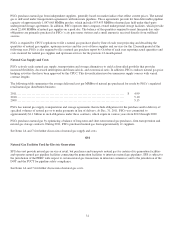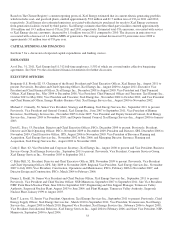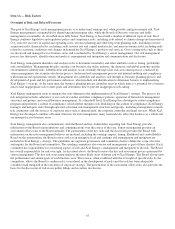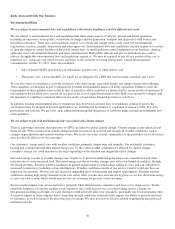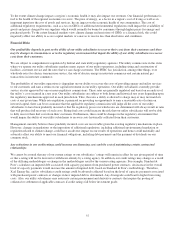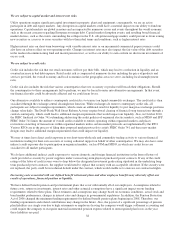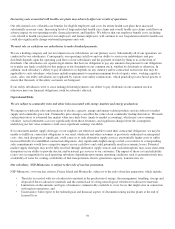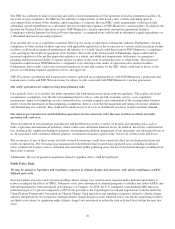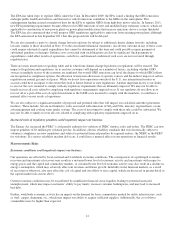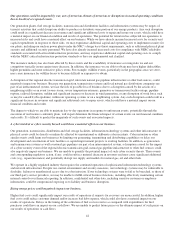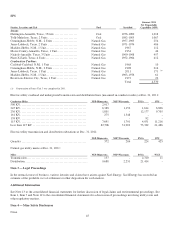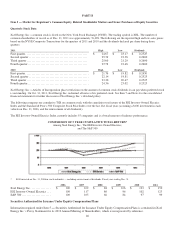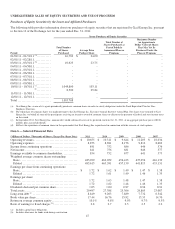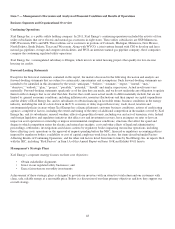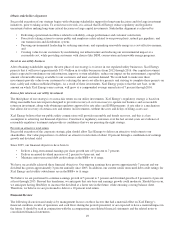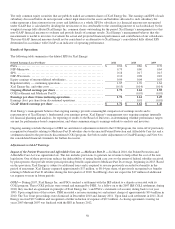Xcel Energy 2011 Annual Report Download - page 50
Download and view the complete annual report
Please find page 50 of the 2011 Xcel Energy annual report below. You can navigate through the pages in the report by either clicking on the pages listed below, or by using the keyword search tool below to find specific information within the annual report.40
The NRC has authority to impose licensing and safety-related requirements for the operation of nuclear generation facilities. In
the event of non-compliance, the NRC has the authority to impose fines or shut down a unit, or both, depending upon its
assessment of the severity of the situation, until compliance is achieved. Revised NRC safety requirements could necessitate
substantial capital expenditures or a substantial increase in operating expenses at NSP-Minnesota’s nuclear plants. In addition, the
Institute for Nuclear Power Operations reviews NSP-Minnesota’s nuclear operations and nuclear generation facilities.
Compliance with the Institute for Nuclear Power Operations’ recommendations could result in substantial capital expenditures or
a substantial increase in operating expenses.
If an incident did occur, it could have a material effect on our results of operations or financial condition. Furthermore, the non-
compliance of other nuclear facilities operators with applicable regulations or the occurrence of a serious nuclear incident at other
facilities could result in increased regulation of the industry as a whole, which could then increase NSP-Minnesota’s compliance
costs and impact the results of operations of its facilities. The events at the nuclear plant in Fukushima, Japan could result in
increased regulation of the nuclear generation industry as a whole, and additional requirements with respect to emergency
planning and demonstrated ability to operate nuclear facilities in the event of natural disasters or other events. This increased
regulation could increase NSP-Minnesota’s compliance costs and impact the results of operations of its nuclear facilities.
Furthermore, these events could cause increased regulatory review and scrutiny by the NRC which could lead to delays in the
process for obtaining required regulatory reviews and approvals.
NSP-Wisconsin’s production and transmission system is operated on an integrated basis with NSP-Minnesota’s production and
transmission system, and NSP-Wisconsin may be subject to risks associated with NSP-Minnesota’s nuclear generation.
Our utility operations are subject to long-term planning risks.
On a periodic basis, or as needed, our utility operations file long-term resource plans with our regulators. These plans are based
on numerous assumptions over the relevant planning horizon such as: sales growth, economic activity, costs, regulatory
mechanisms, impact of technology on sales and production, customer response and continuation of the existing utility business
model. Given the uncertainty in these planning assumptions, there is a risk that the magnitude and timing of resource additions
and demand may not coincide. This could lead to under recovery of costs or insufficient resources to meet customer demand.
Our natural gas transmission and distribution operations involve numerous risks that may result in accidents and other
operating risks and costs.
There are inherent in our natural gas transmission and distribution activities a variety of hazards and operating risks, such as
leaks, explosions and mechanical problems, which could cause substantial financial losses. In addition, these risks could result in
loss of human life, significant damage to property, environmental pollution, impairment of our operations and substantial losses to
us. In accordance with customary industry practice, we maintain insurance against some, but not all, of these risks and losses.
The occurrence of any of these events not fully covered by insurance could have a material effect on our financial position and
results of operations. For our natural gas transmission or distribution lines located near populated areas, including residential
areas, commercial business centers, industrial sites and other public gathering areas, the level of potential damages resulting from
these risks is greater.
Additionally, the cost of potential regulations related to pipeline safety could be significant.
Public Policy Risks
We may be subject to legislative and regulatory responses to climate change and emissions, with which compliance could be
difficult and costly.
Increased public awareness and concern regarding climate change may result in more regional and/or federal requirements to
reduce or mitigate the effects of GHGs. Numerous states have announced or adopted programs to stabilize and reduce GHGs, and
federal legislation has been introduced in both houses of Congress. In 2009, the U.S. submitted a non-binding GHG emission
reduction target of 17 percent compared to 2005 levels pursuant to the Copenhagen Accord and negotiations continue under the
United Nations Framework Convention on Climate Change. Such legislative and regulatory responses related to climate change
and new interpretations of existing laws through climate change litigation create financial risk as our electric generating facilities
are likely to be subject to regulation under climate change laws introduced at either the state or federal level within the next few
years.



